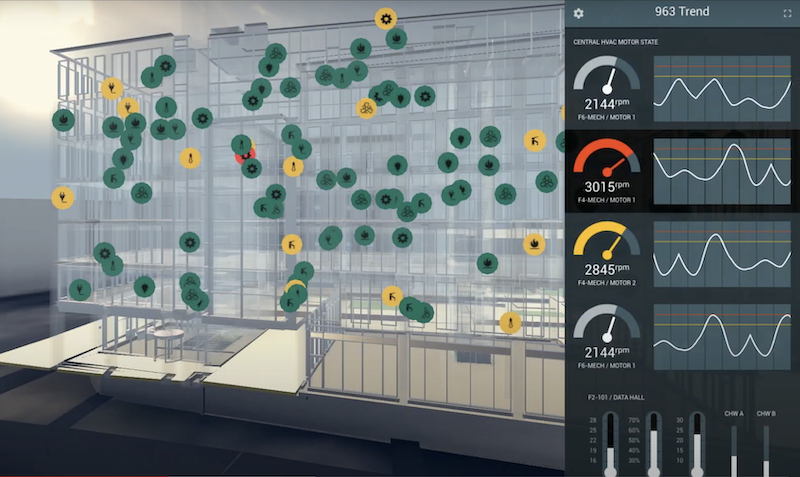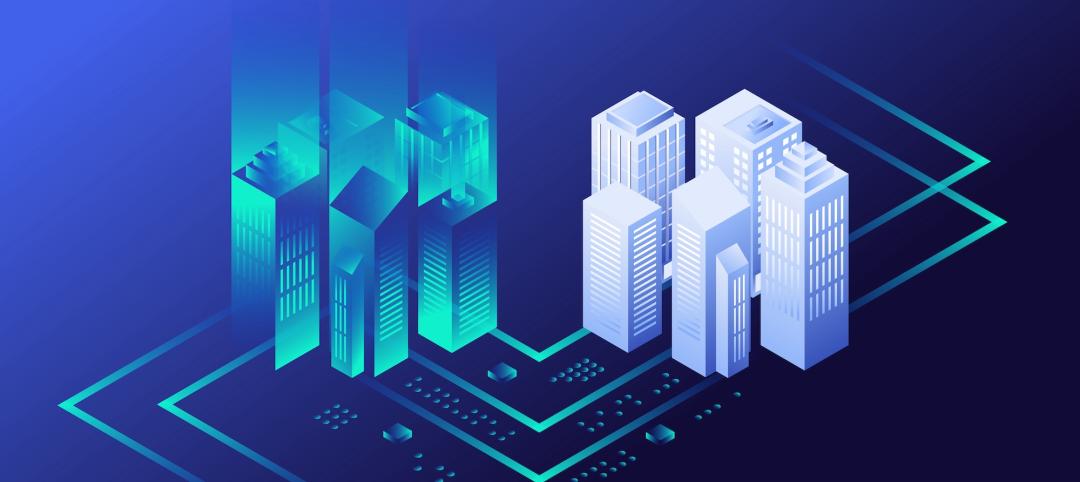Advancements in artificial intelligence, sensors, machine learning, and the Internet of Things and Assets are moving digital twin technology beyond the concept stage to where it is emerging as an invaluable lifecycle assessment and management tool for new and existing buildings.
Ernst & Young Global Limited (EY) has released a white paper titled Digital Twin: the Age of Aquarius in construction and real estate, which outlines the technology’s value proposition for building maintenance and operations, environmental impact and sustainability, health and wellness, and “people improvement” and real estate interface.
Drawing on a host of sources and examples, the white paper concludes that the adoption of digital twin can reduce real estate operating costs by up to 35%, decrease carbon emissions, deliver a healthier workplace, and enhance user experiences.
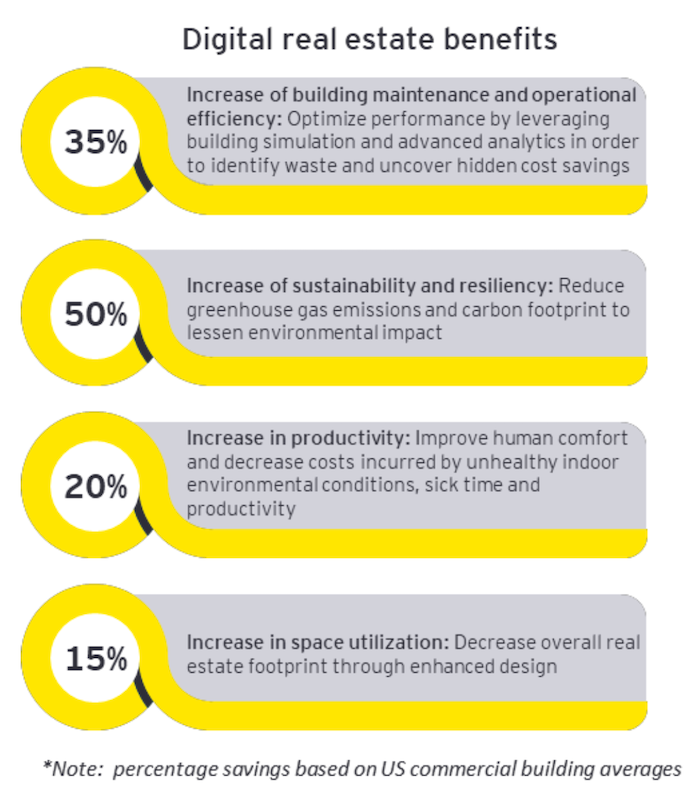 Sustainability and resilence are where digital twin could have its greatest impact on the built environment. Image: EY
Sustainability and resilence are where digital twin could have its greatest impact on the built environment. Image: EY
“Digital twin technology is able to accelerate corporate evolution, incorporating sustainable design to drive operational excellence” the white paper states. Achieving that acceleration, though, must address challenges that include cybersecurity, occupant expectations of privacy, and the development of the right internal skillsets for implementation.
What construction and real estate firms must also decide is whether they are willing to make the upfront investment required to capture the kind of future ROI that the white paper unambiguously believes digital twin will deliver. “By taking this initiative, the early adopters will reap the greatest benefits and be considered as pioneers in building the next generation of real estate,” the paper states. “It will provide these firms a competitive advantage in the industry while incorporating a user-centric business model. This will transform companies of today and create the now, next and beyond of the digital built environment.”
ACCELERATING PROCESS OPTIMIZATION
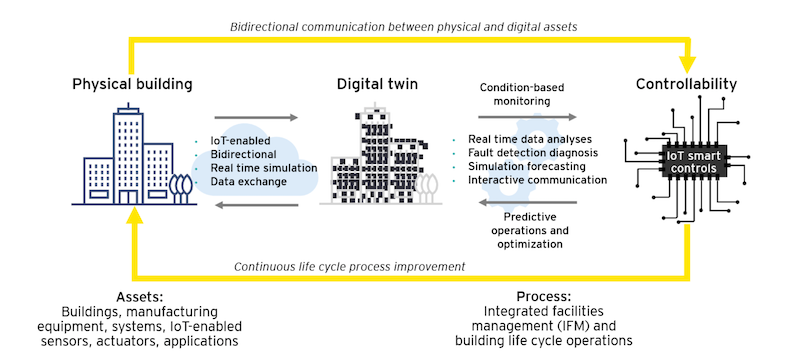 This diagram illustrates how a building talks to its digital twin, and how that twin uses that data to improve its processes. Image: EY
This diagram illustrates how a building talks to its digital twin, and how that twin uses that data to improve its processes. Image: EY
To understand what digital twin can offer, companies must first raise and answer what the white paper calls “tactical questions” about their buildings: how are they monitoring performance, what are their largest operational expenditures, how will technology impact sustainability, what impact can digital twin have on planning, design, and construction?
Three business drivers justify the need for digital twin, says EY: creating a centralized database that can serve as a single source of “truth”; supporting investment decision making; and accelerating continuous process optimization.
That last driver is especially relevant because EY sees digital twin for the built environment as beginning at the component level (say, a building’s HVAC), moving through asset and systems levels, and finally reaching the process level “that provides a big-picture model and overarching framework to an organization. It produces insight into the performance of the entire supply chain,” the white paper states.
FOUR WAYS DIGITAL TWIN’S IMPACT IS PALPABLE
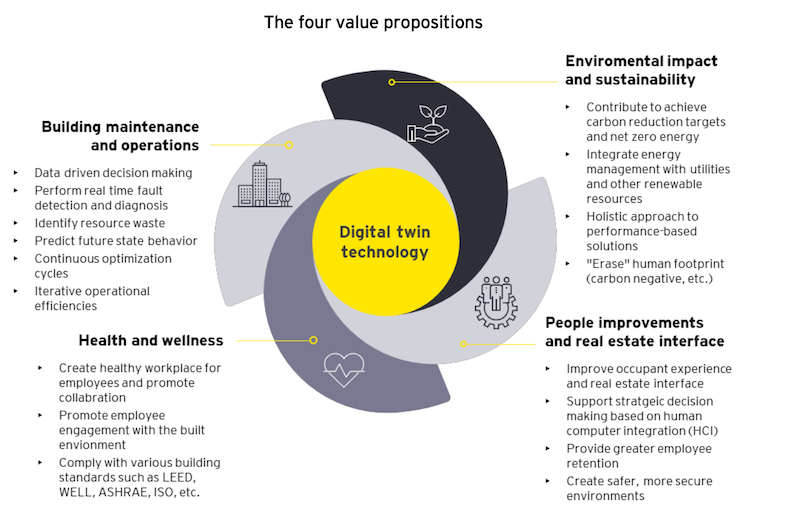 Digital twin technology can be beneficial to a building through its entire lifecycle. Image: EY
Digital twin technology can be beneficial to a building through its entire lifecycle. Image: EY
EY’s paper offers insights into each of digital twin’s value propositions.
Building maintenance and operations: Operations can cost up to five times a building’s capital investment. A recent joint study by Harvard Business School and Microsoft found that two thirds of global organizations are adopting smart technology to control their real estates’ energy use.
Maintenance represents a significant portion of the costs incurred during the asset’s life cycle. The predictive nature of a digital twin can reduce maintenance costs by its ability to collect, monitor and analyze real-time data while utilizing machine-learning models to mitigate future risk.
Communicating predictive maintenance requests is nearly as critical as detecting them. The use of a real-time mobile application that connects to the digital twin has become a common method for relaying information. The white paper points specifically to REScan’s custom scanner technology that can capture 250,000 sf per hour from an eye level point of view. Once digitized, this 3D data enables automatic object finding, which provides contextual information for decision makers, AI algorithms, and robotic applications.
Environmental impact and sustainability. By leveraging digital twins, IoT sensors and IoA augmentation, owners and facility managers can reduce a building’s environmental footprint by decreasing energy consumption from various components and systems.
The white paper singles out Singapore’s Nanyang Technological University, which has explored the use of digital twins to reduce its energy and water use, carbon emissions, and waste across its campus of over 200 buildings. Real time data was analyzed to uncover hidden energy and cost saving opportunities across the various campus utilities.
During the first five years of facility operations, Phase 1 analysis was performed and resulted in a 21% reduction in campus energy consumption, reduced 8.2 kilo ton (kt) of its carbon emissions and provided S$3.9 million (US$2.94 million) in cost savings during this time frame. In the final stage, virtual digital twin models were created using data from Phase 1 and Phase 2 (a total of 10 years) to compare the impact of installing a range of potential technologies. The adoption of these technologies resulted in a total of 31% energy reduction, reduced 9.6kt of carbon emissions and provided S$4.7 million of cost savings over the decade, placing NTU on track toward achieving carbon neutrality.
Health and wellness. Digital twins are expected to play a pivotal role in ensuring workplaces are healthy and safe, by providing organizations with an “advanced toolkit”—deploying sensors, thermal screening, and computational fluid dynamics—to reduce the spread of airborne viruses. By monitoring carbon dioxide levels, owners also meet multiple requirements detailed within the WELL building standards.
Arup’s Tokyo office improved its occupant health and wellness by analyzing employee concentration, stress and heart rate fluctuations via 16 occupancy sensors that covered meeting rooms, private offices, and open spaces. The building also had 12 environmental sensors to measure temperature, humidity and CO2 concentration, and used AI to categorize human emotions based on voice data.
People improvements and real estate interface. JLL recently estimated that between 30% and 40% of office space is underutilized. EY thinks that digital twins can be a viable solution to track occupancy patterns and understand where these inefficiencies lie.
Path of travel is also a pivotal data point that is often overlooked. The digital twin can assist in designing roads, entrances/exits, and parking diagrams to align with peak traffic flows. Inversely, the digital twin could optimize employee’s schedules to skip high traffic periods.
Building owners can also enhance the security for their employees and assets by installing automated security systems within the digital twin. AI image recognition in the IoT network would monitor areas that are typically monitored by security personnel. Threat detection is substantially improved and no longer requires as large of a security team. Companies can reduce labor costs pertaining to security up to 50% by leveraging a digital twin model, the white paper estimates.
CREATING A TRUE AS-BUILT REPLICA
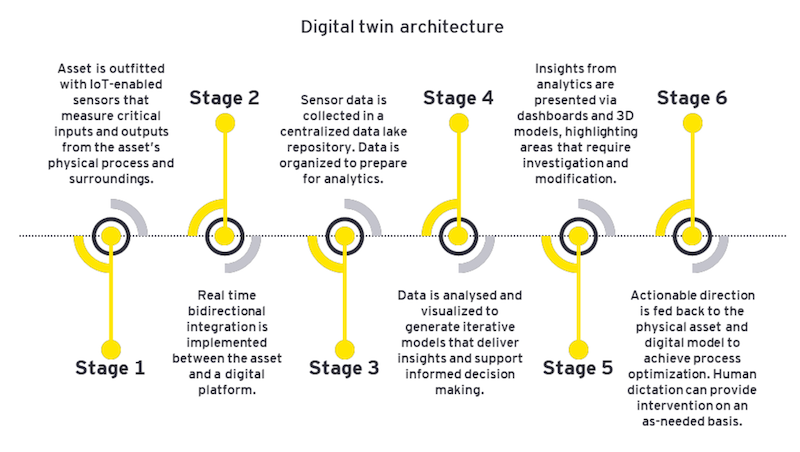 How a digital twin is constructed. Image: EY
How a digital twin is constructed. Image: EY
EY’s paper also offers ways that digital twin can be used across each stage of an asset’s life cycle, from “testing what if’s” for financing, planning and design, to “reducing human error and bias” in new construction or renovation, and commissioning and “calibration” so that, in essence, “the physics-based twin becomes a true replica of the as-built conditions.”
As business priorities are constantly evolving over the life cycle of a building, a digital twin that improves itself over time can provide dynamic modeling and “an agile approach to decision-making and management,” the white paper states.
Download EY's white paper, Digital Twin: the Age of Aquarius in construction and real estate
Related Stories
Digital Twin | Aug 21, 2024
Digital twins: Transforming operations for greater efficiency
While efforts to improve building efficiency have been iterative, recent advancements have significantly enhanced the interaction between facility managers, building owners, and their facilities.
AEC Innovators | Apr 26, 2024
National Institute of Building Sciences announces Building Innovation 2024 schedule
The National Institute of Building Sciences is hosting its annual Building Innovation conference, May 22-24 at the Capital Hilton in Washington, D.C. BI2024 brings together everyone who impacts the built environment: government agencies, contractors, the private sector, architects, scientists, and more.
AEC Tech | Mar 9, 2024
9 steps for implementing digital transformation in your AEC business
Regardless of a businesses size and type, digital solutions like workflow automation software, AI-based analytics, and integrations can significantly enhance efficiency, productivity, and competitiveness.
AEC Tech | Feb 28, 2024
How to harness LIDAR and BIM technology for precise building data, equipment needs
By following the Scan to Point Cloud + Point Cloud to BIM process, organizations can leverage the power of LIDAR and BIM technology at the same time. This optimizes the documentation of existing building conditions, functions, and equipment needs as a current condition and as a starting point for future physical plant expansion projects.
AEC Innovators | Feb 28, 2024
How Suffolk Construction identifies ConTech and PropTech startups for investment, adoption
Contractor giant Suffolk Construction has invested in 27 ConTech and PropTech companies since 2019 through its Suffolk Technologies venture capital firm. Parker Mundt, Suffolk Technologies’ Vice President–Platforms, recently spoke with Building Design+Construction about his company’s investment strategy.
AEC Tech | Jan 8, 2024
What's driving the surge of digital transformation in AEC today?
For centuries, the AEC industry has clung to traditional methods and legacy processes—seated patterns that have bred resistance to change. This has made the adoption of new technologies a slow and hesitant process.
Digital Twin | Jul 31, 2023
Creating the foundation for a Digital Twin
Aligning the BIM model with the owner’s asset management system is the crucial first step in creating a Digital Twin. By following these guidelines, organizations can harness the power of Digital Twins to optimize facility management, maintenance planning, and decision-making throughout the building’s lifecycle.
Digital Twin | Jul 17, 2023
Unlocking the power of digital twins: Maximizing success with OKRs
To effectively capitalize on digital twin technology, owners can align their efforts using objectives and key results (OKRs).
Digital Twin | May 8, 2023
What AEC professionals should know about digital twins
A growing number of AEC firms and building owners are finding value in implementing digital twins to unify design, construction, and operational data.
Digital Twin | Nov 21, 2022
An inside look at the airport industry's plan to develop a digital twin guidebook
Zoë Fisher, AIA explores how design strategies are changing the way we deliver and design projects in the post-pandemic world.


